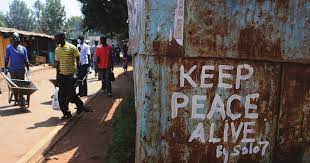The Impact of the Kenya 2008 Post-Election Violence on Rural Farm Households

Nairobi, Kenya: Messages of peace by artist Solomon Muyundo (also known as Solo 7) mark
the walls throughout Kibera, Kenya’s largest slum.
(Michelle Shephard / Toronto Star via Getty Images)
Study Context
On December 30, 2007, Kenya experienced its worst post-election violence (PEV) since the inception of multiparty politics in 1992. The violence persisted until the end of February 2008 and more than 1,100 people died and 650,000 people suffered internal displacement (Adeagbo & Iyi, 2011). Rivalry between dominant ethnic groups such as the Kikuyu and the Kalenjin, and disputes over the control of scarce arable land have led to PEV, impacting the socio-economic outcomes of agricultural households (Oucho, 2010). While existing literature mainly focuses on the causes of PEV in Kenya (Dercon & Gutiérrez-Romero, 2012; Klopp & Kamungi, 2007; Oucho, 2010), there is limited empirical evidence on the effects of PEV on agricultural production and welfare outcomes of farming households. This study will fill this gap by investigating whether and how PEV affects agricultural production and household welfare.
Study Design
This study used an objective measure of PEV using conflict data from Armed Conflict Location & Event Data Project (ACLED), Commission of Inquiry into Post-Election Violence (CIPEV), and Uppsala Conflict Data Program (UCDP), which reported information on internal political conflict primarily by date, location, and actor. Combining the household data with external data measuring PEV reduced measurement error associated with using self-reported measures of PEV.
The final dataset included a balanced panel of 1,243 households in 22 districts sampled from eight agro-regional and agro-ecological zones. Spanning ten years, the panel contained four waves of data from the 2000, 2004, 2007, and 2010 surveys.
The study used a DID estimator to measure the average treatment effect on the treated (ATET) in order to address endogeneity concerns and assess how PEV impacts agricultural production and consumption expenditure on rural farm households in Kenya.
Results and Policy Lessons
Exposure to the 2008 PEV crisis had a negative impact on household welfare. In particular, the PEV crisis reduced household per capita income and increased household poverty. Correspondingly, the PEV crisis causally increased household poverty.
Whereas ex ante (e.g. on-farm and off-farm diversification) and ex post strategies (e.g. sale of assets and off-farm diversification) may play a role in reducing the magnitude of adverse welfare impacts, they are unlikely to fully eliminate them.
Exposure to the 2008 PEV crisis had a positive impact on off-farm income, suggesting that farming households may have substituted on-farm activities with non-farm activities, including off-farm employment and informal employment (Adong et al., 2021). It is plausible that households opted to engage in income generating activities and informal labor activities for their livelihoods during the period of unrest. Various studies argue that off-farm diversification including non-farm activities provide alternative sources of income and employment.

